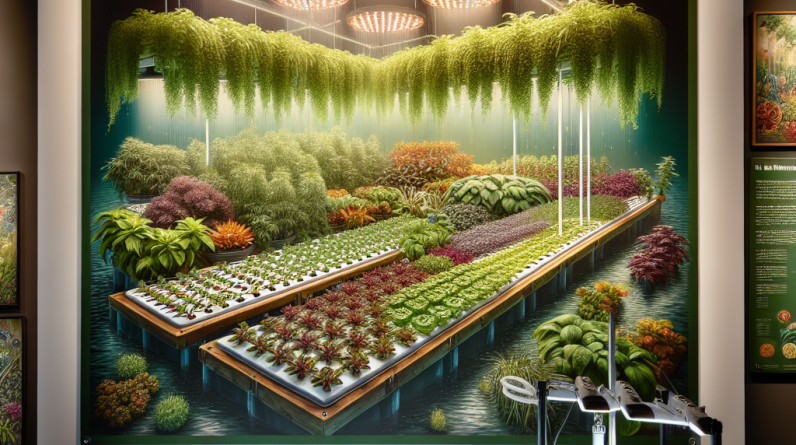
Understanding Hydroponics: The Basics
What is Hydroponics?
Alright folks, let’s get down to it. Hydroponics is a method of growing plants without soil, using nutrient-rich water instead. It’s actually pretty fascinating how plants can thrive in this setup. You get to control everything from light to nutrient intake, which means healthier plants and, ideally, higher yields.
The term “hydroponics” is derived from the Greek words for water (“hydro”) and labor (“ponos”), essentially meaning “working water.” This technique allows gardeners like us to grow a variety of plants in a shorter time span and in less space. Talk about a win-win!
It’s also worth mentioning that there are various hydroponic systems like nutrient film technique (NFT), aquaponics, and deep water culture (DWC). Each has its perks and quirks, but the end goal is the same: to grow plants efficiently. Let’s dive deeper!
Choosing the Right System for Your Needs
Main Hydroponic Systems
First things first, you’ve got to figure out which hydroponic system fits your style. Each system has its pros and cons based on what you’re trying to grow and your available space. For instance, if you’re short on space but want a quick crop, consider the vertical farming method!
Then there’s the classic deep water culture, which is super beginner-friendly. Plants are suspended in a nutrient solution, making it easier for newbies like me to get started without too much fuss. It could be the best option if you’re looking to experiment.
Don’t overlook aeroponics or drip systems, either! They can give you higher yields and are quite popular among advanced gardeners. Just weigh your options before diving in—literally!
Essential Nutrients for Optimal Growth
The Importance of Nutrients
Let’s chat about nutrients. This is the bread and butter of growing hydroponically. Plants need a mix of macronutrients and micronutrients for healthy growth. Key players include nitrogen, phosphorus, potassium, calcium, magnesium, and iron.
However, it’s not just about having these nutrients—it’s about getting the ratios right. Too much of one thing can lock out another nutrient, turning your dreams of high yields into a nightmare. Trust me, trial and error is a part of the process, but learning from those mistakes is what makes us better growers.
You can always use ready-made nutrient solutions found at garden centers, but sometimes whipping up your own blend can be a fun experiment. Just make sure to monitor the pH of your solution. It’s crucial to keep it within an optimal range to maximize nutrient availability!
Monitoring Environmental Conditions
Key Factors to Observe
This part is where many new hydroponic gardeners fall short. You need to maintain the right environmental conditions. Temperature, humidity, and light can influence plant growth drastically.
For instance, leafy greens love cooler temps, while fruiting plants like tomatoes thrive in warmth. Make sure to research the specific needs of the plants you’re growing. Yes, it takes some homework, but it’s worth it for those juicy tomatoes!
Light is another biggie. Plants need a good amount of light to photosynthesize. If you don’t have ample natural light, invest in some grow lights. The right lighting can transform your setup and boost those yields astronomically.
Harvesting and Maintenance Procedures
When and How to Harvest
Finally, let’s talk harvest time. The moment we’ve all been waiting for! Knowing when to harvest can mean the difference between a mediocre yield and a bumper crop. Most leafy greens can be harvested 30-45 days after planting, while fruiting plants often take a bit longer.
One key tip here: don’t rush your harvest. Allowing your plants to reach their peak flavor and ripeness can seriously enhance your yield’s quality. Plus, who doesn’t love the taste of homegrown produce?
After you’ve enjoyed the fruits of your labor, remember that maintaining your system is crucial for continued success. Clean out your reservoir regularly, check for algae growth, and, of course, keep learning as you go! Each crop teaches you something new.
FAQs
1. What is the most efficient hydroponic system for beginners?
The deep water culture system is generally considered the most beginner-friendly. It’s straightforward and allows for robust plant development.
2. How often should I check the nutrient solution?
It’s a good practice to check the nutrient solution at least once a week. You’ll want to monitor pH levels and nutrient concentration to ensure optimal growth.
3. Can I grow all types of plants hydroponically?
Most certainly! While leafy greens and herbs are the easiest, many fruiting plants, like tomatoes and peppers, can also be grown hydroponically with the right system and care.
4. What’s the best way to prevent pests in a hydroponic setup?
Regularly inspecting your plants, maintaining cleanliness, and using natural pest deterrents can help keep pests at bay. Consider introducing beneficial insects like ladybugs too!
5. How can I improve my yields further?
Continuously educate yourself, experiment with different nutrient solutions, and monitor your environmental conditions closely. Small tweaks can lead to big results!







